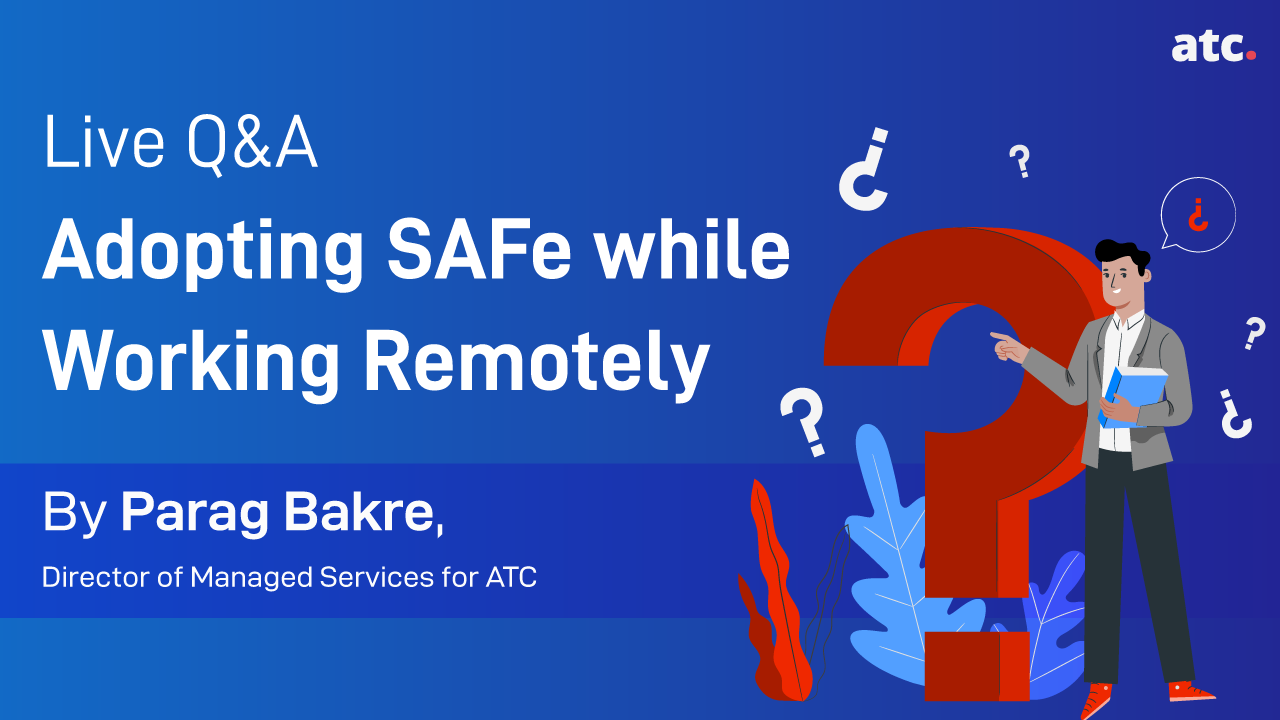Subscribe to the blog
As organizations want the benefits of remote workers, without missing out on the advantages of agile methodologies, how does remote working fit into an agile organization?
How do scattered agile teams conduct PI Planning and other associated activities that typically require face-to-face interaction?
Our monthly SAFe Training Q&A session for our SAFe trainees happened on April 9 and focused on implementing SAFe practices when working from remote. Here are the answers to the questions raised during the SAFe training session.
Hosting Virtual PI Planning Sessions
Traditionally, activities like PI Planning are designed for team members who are together and interact in person.
Here are some ways to successfully carry out PI Planning Sessions from remote:
1. Using cloud-based tools
Using collaborative tools like Realtime Board or Miro, you can create visible planning task boards for agile teams. It also helps to map cross dependencies and ensures that information isn't stored in different places. Teams hence end up using a single source for information access and transfer.
2. Using video and audio
Tools like Zoom and Google Hangouts help teams connect through video and audio. Screens can be shared on the call to ensure that instructions are clear and making sure that standup meetings and planning sessions happen seamlessly.
3. Setting the rules
While it's essential to use technology, it's equally important to set the rules ahead of time on how these sessions are conducted. It helps avoid interference and other discussions that could disrupt your team's focus.
Why Promote SAFe?
Implementing the Scaled Agile Framework is an organizational change. SAFe Agilist certified professionals need to take the initiative at the enterprise level by touching upon common pain points such as:
- Faster time-to-market
- Improved employee morale
- Better quality
- Increased productivity
By addressing common challenges and highlighting the benefits that SAFe brings to the table, you need to act as the change agent and guide the top management to understand the reason why SAFe is the right choice.
Why Do You Need a SAFe Transformation Partner?
It is imperative to align with SAFe Transformation Partners when an organization is implementing the Scaled Agile Framework. Authorized Partners are equipped to help organizations achieve better alignment, cadence, synchronization, and collaboration across the organization. ATC is a Gold Partner of Scaled Agile, Inc., having over a decade of experience in SAFe Training & Transformation will help you navigate your transformation journey at ease and produce assured results. Hence, we recommend that you choose a SAFe approved partner and not an independent consultant, who may be cheaper to start with but will not be equipped enough to bring out an organizational change.
Click here to know more and get in touch with us.
How to Implement SAFe?
Here are some steps in which SAFe can be successfully implemented at an organizational level.
- An essential prerequisite for implementing the Scaled Agile Framework is having a Lean-Agile mindset and adhering to its Lean-Agile principles.
- Managing and organizing cross-functional agile teams that are part of the Agile Release Train that incrementally delivers value. It is important to build quality practices along with techniques of Lean and Agile such as Scrum, XP, Kanban, and etcetera.
- Synchronization and cadence ensure that teams are committed to a collaborative, predefined release delivery routine.
- Giving focus on active PI Planning Sessions to bring all the agile teams of the Agile Release Train together and plan the objectives.
- The System Team should implement DevOps and automation to ensure a glitch-free continuous delivery pipeline.
- At the end of every PI, there should be a system demo where teams can present the product.
- Inspect and Adapt session is arranged to address impediments, brainstorm solutions systematically, and identify improvement backlog items.
- Innovative and Planning Iteration discusses the objectives that require fulfillment.
- Architectural Runway lays out the overall technology plan for the software product.
- Lean-Agile Leaders will need to take the responsibility to drive SAFe through training, dispensing, and instilling SAFe to their teams.
SAFe is a Safe Bet
SAFe promotes transparency and collaboration between the development teams and the top management. Enterprises that have implemented SAFe can deliver value, that directly relates to the bottom line. Here are some impressive results reported by several SAFe enterprises:
- 30% happier, more motivated employees
- 35% increase in productivity
- 50% faster time-to-market
- 50% defect reduction
Business Leaders in SAFe
Business Leaders are required to drive and support organizational change and operational effectiveness in the Scaled Agile Framework, and PI planning sessions are the heart of it. That's because, ultimately, it is the leadership team that possesses the experience and authority to influence individuals and groups to achieve their potential.
The Scaled Agile Community
We welcome you to refer and help us grow the Scaled Agile community. For each referral who enrolls for our training courses, we give you a $100 Visa Gift Card. Best of all, there's no limit to the number of people you can refer.
We also deliver online and onsite private classes for groups at their organization’s preferred location.
For more information, please contact us.
Click here to view the full Q&A session.
We conduct monthly Q&A sessions as a continuation of our training program, to help our trainees get answers to their questions in implementing SAFe at their jobs. We provide tips and techniques that are in trend to ensure that Lean-Agile practices are exhibited at scale.
To know more about the various training courses on offer, please visit our training page today.




